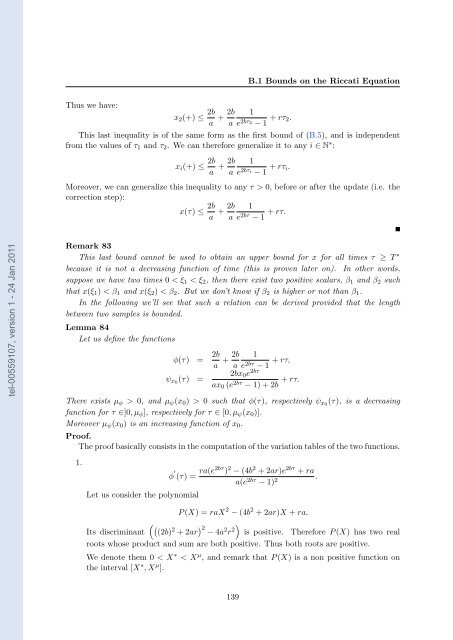Adaptative high-gain extended Kalman filter and applications
Adaptative high-gain extended Kalman filter and applications
Adaptative high-gain extended Kalman filter and applications
Create successful ePaper yourself
Turn your PDF publications into a flip-book with our unique Google optimized e-Paper software.
tel-00559107, version 1 - 24 Jan 2011<br />
Thus we have:<br />
x2(+) ≤ 2b<br />
a<br />
+ 2b<br />
a<br />
B.1 Bounds on the Riccati Equation<br />
1<br />
e2bτ2 + rτ2.<br />
− 1<br />
This last inequality is of the same form as the first bound of (B.5), <strong>and</strong> is independent<br />
from the values of τ1 <strong>and</strong> τ2. We can therefore generalize it to any i ∈ N ∗ :<br />
xi(+) ≤ 2b<br />
a<br />
+ 2b<br />
a<br />
1<br />
e2bτi + rτi.<br />
− 1<br />
Moreover, we can generalize this inequality to any τ > 0, before or after the update (i.e. the<br />
correction step):<br />
x(τ) ≤ 2b 2b 1<br />
+<br />
a a e2bτ + rτ.<br />
− 1<br />
Remark 83<br />
This last bound cannot be used to obtain an upper bound for x for all times τ ≥ T ∗<br />
because it is not a decreasing function of time (this is proven later on). In other words,<br />
suppose we have two times 0 < ξ1 < ξ2, then there exist two positive scalars, β1 <strong>and</strong> β2 such<br />
that x(ξ1) < β1 <strong>and</strong> x(ξ2) < β2. But we don’t know if β2 is <strong>high</strong>er or not than β1.<br />
In the following we’ll see that such a relation can be derived provided that the length<br />
between two samples is bounded.<br />
Lemma 84<br />
Let us define the functions<br />
φ(τ) = 2b<br />
a<br />
ψx0 (τ) =<br />
2b 1<br />
+<br />
a e2bτ + rτ,<br />
− 1<br />
2bx0e2bτ ax0 (e2bτ + rτ.<br />
− 1) + 2b<br />
There exists µφ > 0, <strong>and</strong> µψ(x0) > 0 such that φ(τ), respectively ψx0 (τ), is a decreasing<br />
function for τ ∈]0,µφ], respectively for τ ∈ [0,µψ(x0)].<br />
Moreover µψ(x0) is an increasing function of x0.<br />
Proof.<br />
The proof basically consists in the computation of the variation tables of the two functions.<br />
1.<br />
φ ′<br />
Let us consider the polynomial<br />
(τ) = ra(e2bτ ) 2 − (4b2 +2ar)e2bτ + ra<br />
a(e2bτ − 1) 2 .<br />
P (X) =raX 2 − (4b 2 +2ar)X + ra.<br />
��(2b) � �<br />
Its discriminant 2 2<br />
+2ar − 4a2r2 is positive. Therefore P (X) has two real<br />
roots whose product <strong>and</strong> sum are both positive. Thus both roots are positive.<br />
We denote them 0

















